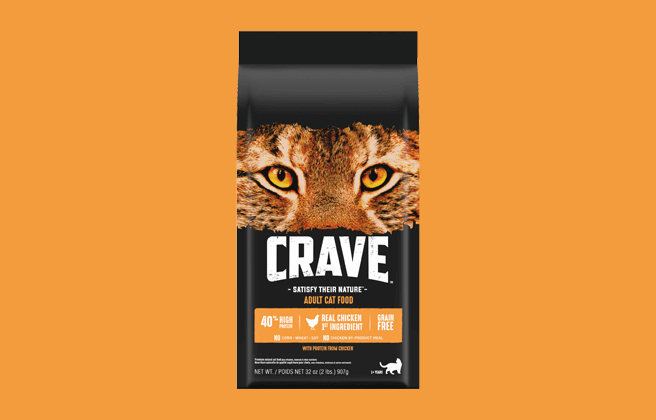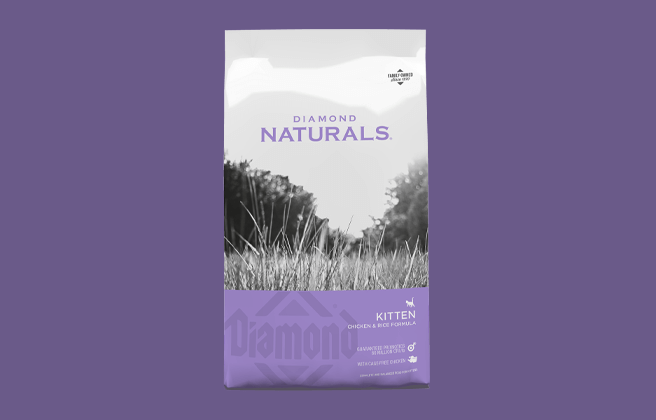
Our Verdict
Purina Pro Plan LiveClear dry cat food is made up of seven recipes with ratings that vary from 3.5 to 4. The average rating of the brand over all is 3.5 stars.
This range of food provides good levels of protein derived from animal meat which is listed as the first ingredient. Each recipe includes antioxidants to help support a healthy immune system.
Pros
- First ingredient listed as animal protein
- High in protein
- Added vitamins and minerals
- Contains natural prebiotic fiber
Cons
- High in carbohydrate
- Contains by-product meal
The table below shows each recipe in this range including our rating and the AAFCO nutrient profile: Growth (kitten), Maintenance (adult), All Life Stages, Supplemental or Unspecified.
| Product line | Rating | AAFCO |
|---|---|---|
| Purina Pro Plan LiveClear Kitten Chicken & Rice Allergen Reducing | 4 | G |
| Purina Pro Plan LiveClear Adult Indoor Turkey & Rice Allergen Reducing | 3.5 | M |
| Purina Pro Plan LiveClear Adult Weight Management Chicken & Rice Allergen Reducing | 3.5 | M |
| Purina Pro Plan LiveClear Allergen Reducing Salmon & Rice Formula | 3.5 | M |
| Purina Pro Plan LiveClear Allergen Reducing Chicken & Rice Formula | 3.5 | M |
| Purina Pro Plan LiveClear Adult 7+ Senior Prime Plus Chicken & Rice Allergen Reducing | 3.5 | M |
| Purina Pro Plan LiveClear Allergen Reducing Sensitive Skin & Stomach Turkey Formula | 4 | M |
Save up to 35%
with Autoship
See discount in cart
Recipe and Label Analysis
Purina Pro Plan LiveClear Kitten Chicken & Rice Allergen Reducing recipe was selected to represent the other products in the line for a detailed recipe and nutrient analysis.
Label and nutrient data below are calculated using dry matter basis.
Purina Pro Plan LiveClear Kitten Chicken & Rice Allergen Reducing recipe
Estimated Dry Matter Nutrient Content
Protein
Fat
CarbsCarbohydrates
Chicken, rice, corn gluten meal, chicken by-product meal, beef fat preserved with mixed-tocopherols, soybean meal, soy protein isolate, dried egg product, fish meal, poultry by-product meal, liver flavor, wheat flour, sodium caseinate, salt, l-lysine monohydrochloride, phosphoric acid, fish oil, dl-methionine, potassium chloride, choline chloride, calcium carbonate, minerals [zinc sulfate, ferrous sulfate, manganese sulfate, copper sulfate, calcium iodate, sodium selenite], vitamins [vitamin E supplement, niacin (vitamin B-3), vitamin A supplement, calcium pantothenate (vitamin B-5), thiamine mononitrate (vitamin B-1), riboflavin supplement (vitamin B-2), vitamin B-12 supplement, pyridoxine hydrochloride (vitamin B-6), folic acid (vitamin B-9), vitamin D-3 supplement, biotin (vitamin B-7), menadione sodium bisulfite complex (vitamin K)], taurine, dried bacillus coagulans fermentation product.
Fiber (estimated dry matter content) = 2.5%
Red denotes any controversial items
Ingredients Analysis
The first ingredient is chicken, which is considered “the clean combination of flesh and skin… derived from the parts or whole carcasses of chicken”. 1
Chicken is naturally rich in the 11 essential amino acids required by a cat to sustain life.
The second ingredient is rice. Is this whole grain rice, brown rice or white rice? Since the word “rice” doesn’t tell us much, it’s impossible to judge the quality of this item.
The third ingredient is corn gluten meal. Gluten is the rubbery residue remaining once corn has had most of its starchy carbohydrate washed out of it.
Although corn gluten meal contains 60% protein, this ingredient would be expected to have a lower biological value than meat.
And less costly plant-based products like this can notably boost the total protein reported on the label — a factor that must be considered when judging the actual meat content of this cat food.
The fourth ingredient is chicken by-product meal, a dry rendered product of slaughterhouse waste. It’s made from what’s left of a slaughtered chicken after all the choice cuts have been removed.
On the brighter side, by-product meals are meat concentrates and contain nearly 300% more protein than fresh chicken.
The fifth ingredient is beef fat preserved with mixed-tocopherols. Beef fat (or tallow) is most likely obtained from rendering, a process similar to making soup in which the fat itself is skimmed from the surface of the liquid.
Although it may not sound very appetizing, beef fat is actually a quality ingredient.
The sixth ingredient is soybean meal, a by-product of soybean oil production more commonly found in farm animal feeds.
Although soybean meal contains 48% protein, this ingredient would be expected to have a lower biological value than meat.
And less costly plant-based products like this can notably boost the total protein reported on the label — a factor that must be considered when judging the actual meat content of this cat food.
The seventh ingredient is soy protein isolate, what remains of soybeans after removing the water soluble carbohydrates from the beans.
Even though it contains over 80% protein, this ingredient would be expected to have a lower biological value than meat.
And less costly plant-based products like this can notably boost the total protein reported on the label — a factor that must be considered when judging the actual meat content of this cat food.
The eighth ingredient is dried egg product, a dehydrated form of shell-free eggs. Quality can vary significantly. Lower grade egg products can even come from commercial hatcheries – from eggs that have failed to hatch.
In any case, eggs are easy to digest and have an exceptionally high biological value.
From here the list goes on to include a number of other items. But to be realistic, ingredients located this far down the list (other than nutritional supplements) are not likely to affect the overall rating of the product.
We note the inclusion of dried fermentation products in this recipe. Fermentation products are typically added as probiotics to aid with digestion.
We note the inclusion of some controversial ingredients such as poultry by-product meal, a dry rendered product of slaughterhouse waste. It’s made from what’s left of slaughtered poultry after all the prime cuts have been removed.
In addition to organs, this item can also include feet, beaks, undeveloped eggs and almost anything other than prime skeletal muscle.
This recipe also contains wheat flour, a highly-refined product of wheat milling. Like corn, wheat is an inexpensive and controversial cereal grain of only modest nutritional value to a cat.
For this reason, we do not consider wheat a preferred component in any cat food.
Finally, this food contains menadione sodium bisulfite complex, a controversial form of vitamin K linked to liver toxicity, allergies and the abnormal break-down of red blood cells.
Since vitamin K isn’t required by AAFCO in its nutrient profiles, we question the use of this item in any feline recipe.
Save up to 35%
with Autoship
See discount in cart
Nutrient Analysis
Based on its ingredients alone, Purina Pro Plan LiveClear Kitten Chicken & Rice Allergen Reducing recipe looks like an average dry product.
The dashboard displays a dry matter protein reading of 47.7%, a fat level of 21.6% and an estimated carbohydrate level of 22.7%.
As a group, the brand features an above-average protein content of 43.6% and an above-average fat level of 17.6%. Together these figures suggest a carbohydrate content of 30.8% for the overall product line, alongside a fat to protein ratio of 40%.
This means this Purina Pro Plan LiveClear dry range contains higher than average protein, near-average carbohydrate, and higher than average fat, when compared to typical dry cat food.
Final Word
This range of food has been formulated to reduce allergen in cat hair and dander. This food also contains omega-6 fatty acids and vitamin A which can help nourish a cat’s skin and coat.
Has Purina Pro Plan LiveClear cat food been recalled in the past?
Yes, Purina has had a number of cat food recalls over the years.
The last one was in July 2021 when cans of Purina Pro Plan Complete Essentials Tuna Entree in Sauce Wet Cat Food were recalled as they may have contained plastic.
In March 2019, Purina issued a recall of one of its Muse cat foods.
In 2012, a single lot of Purina Veterinary Diets OM Overweight Management Feline Formula was recalled due to low levels of thiamine. Production Code #11721159.
In June 2011, Friskies issued a small recall due to the potential risk of salmonella contamination. This recall only affected a small range of Friskies products, – the Friskies Grillers Blend dry cat food recipe in 3.15lb and 16 lb bags with best-by dates of August 2012.
In the same year, some other Purina dry cat foods were recalled due to suspected salmonella contamination. The products affected were: Purina ONE Vibrant Maturity 7+ dry cat food, 3.5 lb. and 7 lb. bags, with a “Best by” date of May 2012 and Production Code #03341084 or #03351084 and Purina Cat Chow Naturals, 6.3 lb., Production Code #10331083 13, with “Best by” date of August 2012.
You can view a complete list of all cat food recalls since 2021 here.
To stay on top of any cat food product recalls, sign up for our free email alerts, here.
About
Nestlé Purina PetCare is an American subsidiary of the Swiss corporation Nestlé, based in St. Louis, Missouri. It produces and markets pet food, treats, cat and dog litter.
The cat food brands owned by Purina are: Beyond, Breeze, DenaLife, Fancy Feast, Friskies, Kit & Kaboodle, Petivity, Purina Cat Chow, Purina ONE, Purina Pro Plan, Purina Pro Plan Veterinary Diets, Tidy Cats and Whisker Lickin’s.
Best cat foods
We uphold the highest editorial standards when creating the authoritative content pet parents rely on and trust.
Every piece of clinical content on the Cat Food Advisor is reviewed by our certified Veterinary Advisory Board, which consists of licensed veterinarians and medically certified specialists.
Our reviews are completely independent; we are not paid by any pet food company to promote their products favorably. We do not accept money, gifts, samples or other incentives in exchange for special consideration. For more information see our Disclaimer & Disclosure page.













